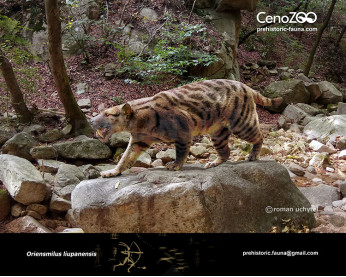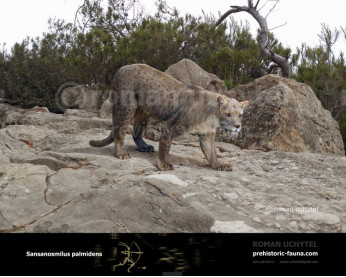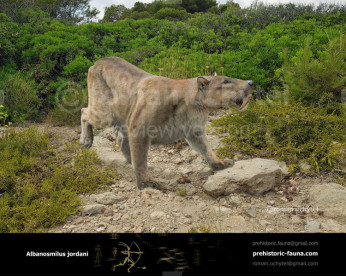Barbourofelis loveorum
120120Barbourofelis loveorum (Barbourofelis loveorum Baskin 1981)
Order: Carnivora
Family: Barbourofelidae
Range and period of existence: Middle to Late Miocene of North America
Dimensions: length - 1,6 m, height - 80 cm, weight - 50 -130 kg.
Barbourofelis is an extinct genus of large, mostly carnivorous mammals of the family Barbourofelidae (false saber-tooth cats) endemic to North America, during the Miocene living from 12—7 Ma and existed for approximately 5 million years.
A single specimen of Barbourofelis loveorum was examined by scintist for body mass. The first specimen was estimated to weigh 66.4 kg. Thought to possibly be jaguar-sized and had the long canines of all barbourofelids. They had very prominent flanges on the lower jaws and an unusually shaped skull. The skull of Barburofelis was shortened to a greater degree than in kind of saber-toothed cats Smilodon, and hypertrophied upper canines were perhaps even more advanced. The lower jaw, as well as saber-toothed predators have all been relatively weak, the lower teeth are not large, the set of teeth is shortened. On the lower jaw bone, there were specific processes that are characteristic for the early saber-toothed cats, but more pronounced than in the past. A very interesting structure of the rear limb girdle of Barburofelis. The barbourofelids were probably very muscular, resembling a bear-like cat or cat-like bear.
B. loveorum possibly evolved from B. morrisi, and may have evolved into B. fricki. It's believed that Barbourofelis was an ambulatory, ambush predator that hunted within closed forested environments.
Barbourofelis loveorum (Barbourofelis loveorum Baskin 1981)
Order: Carnivora
Family: Barbourofelidae
Range and period of existence: Middle to Late Miocene of North America
Dimensions: length - 1,6 m, height - 80 cm, weight - 50 -130 kg.
Barbourofelis is an extinct genus of large, mostly carnivorous mammals of the family Barbourofelidae (false saber-tooth cats) endemic to North America, during the Miocene living from 12—7 Ma and existed for approximately 5 million years.
A single specimen of Barbourofelis loveorum was examined by scintist for body mass. The first specimen was estimated to weigh 66.4 kg. Thought to possibly be jaguar-sized and had the long canines of all barbourofelids. They had very prominent flanges on the lower jaws and an unusually shaped skull. The skull of Barburofelis was shortened to a greater degree than in kind of saber-toothed cats Smilodon, and hypertrophied upper canines were perhaps even more advanced. The lower jaw, as well as saber-toothed predators have all been relatively weak, the lower teeth are not large, the set of teeth is shortened. On the lower jaw bone, there were specific processes that are characteristic for the early saber-toothed cats, but more pronounced than in the past. A very interesting structure of the rear limb girdle of Barburofelis. The barbourofelids were probably very muscular, resembling a bear-like cat or cat-like bear.
B. loveorum possibly evolved from B. morrisi, and may have evolved into B. fricki. It's believed that Barbourofelis was an ambulatory, ambush predator that hunted within closed forested environments.

1-797x638.jpg)
-797x638.jpg)
-797x638.jpg)
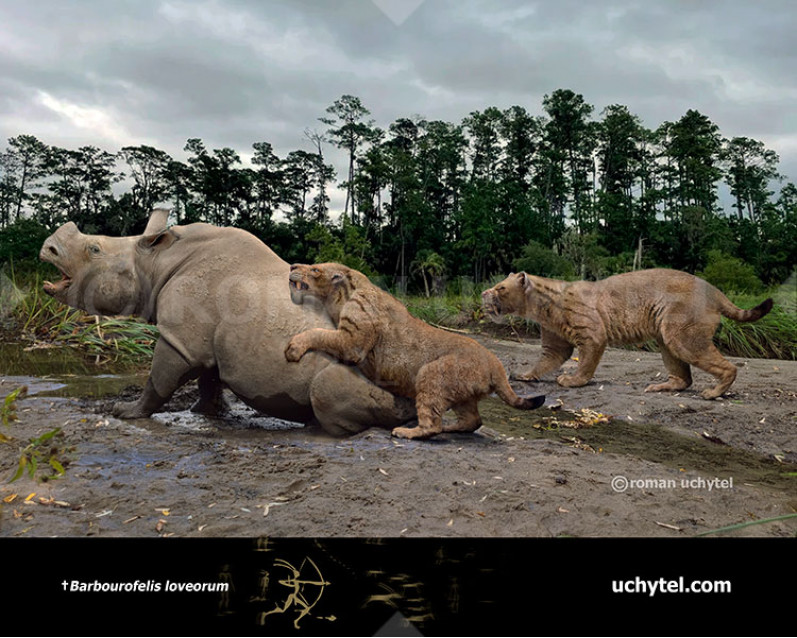
-797x638.jpg)
1-70x56.jpg)
-70x56.jpg)
-70x56.jpg)

-70x56.jpg)
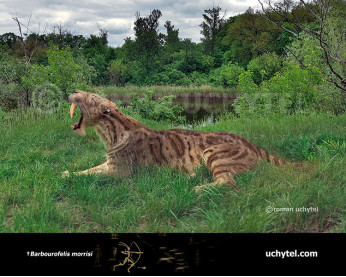
-346x277.jpg)
-346x277.jpg)
